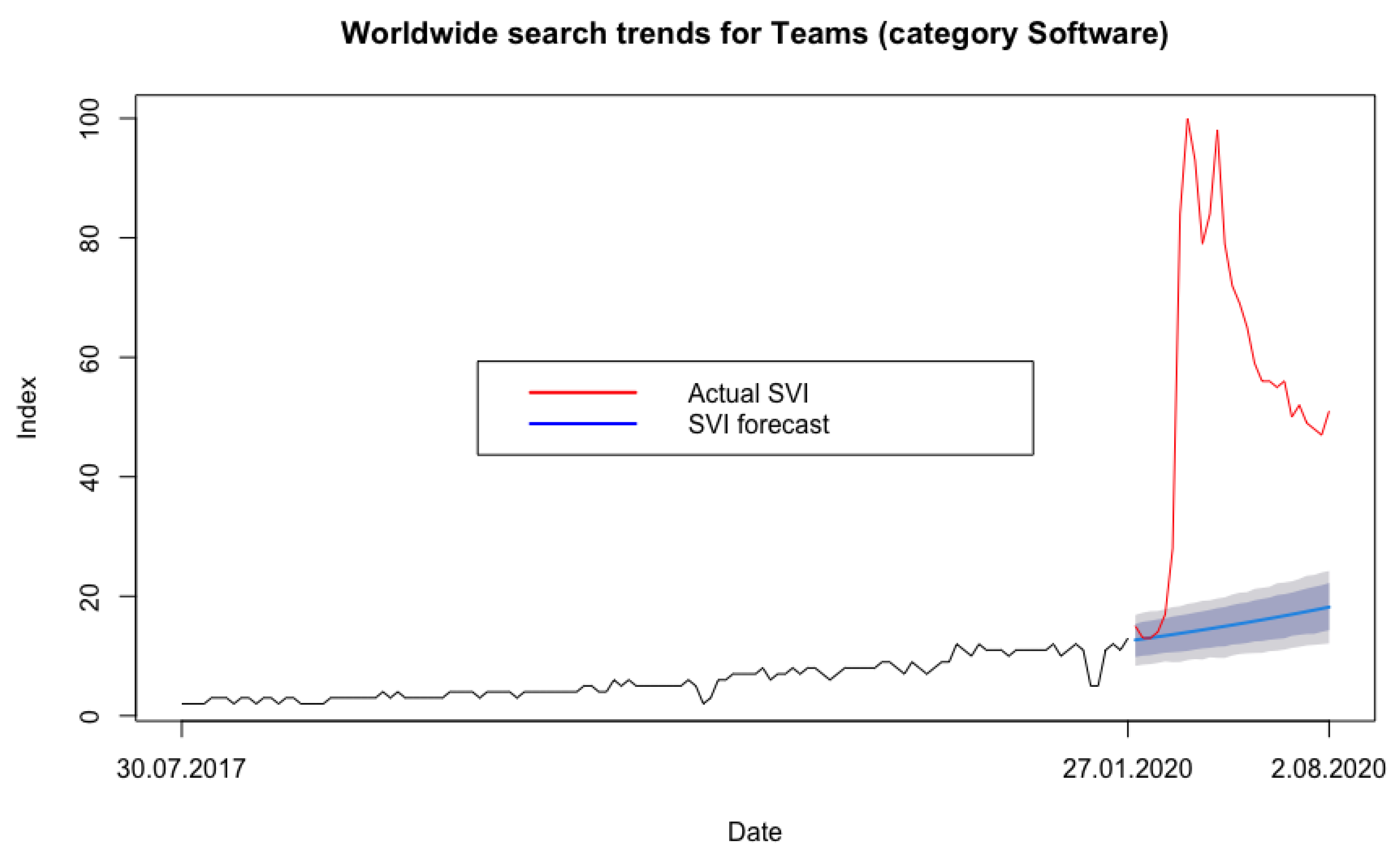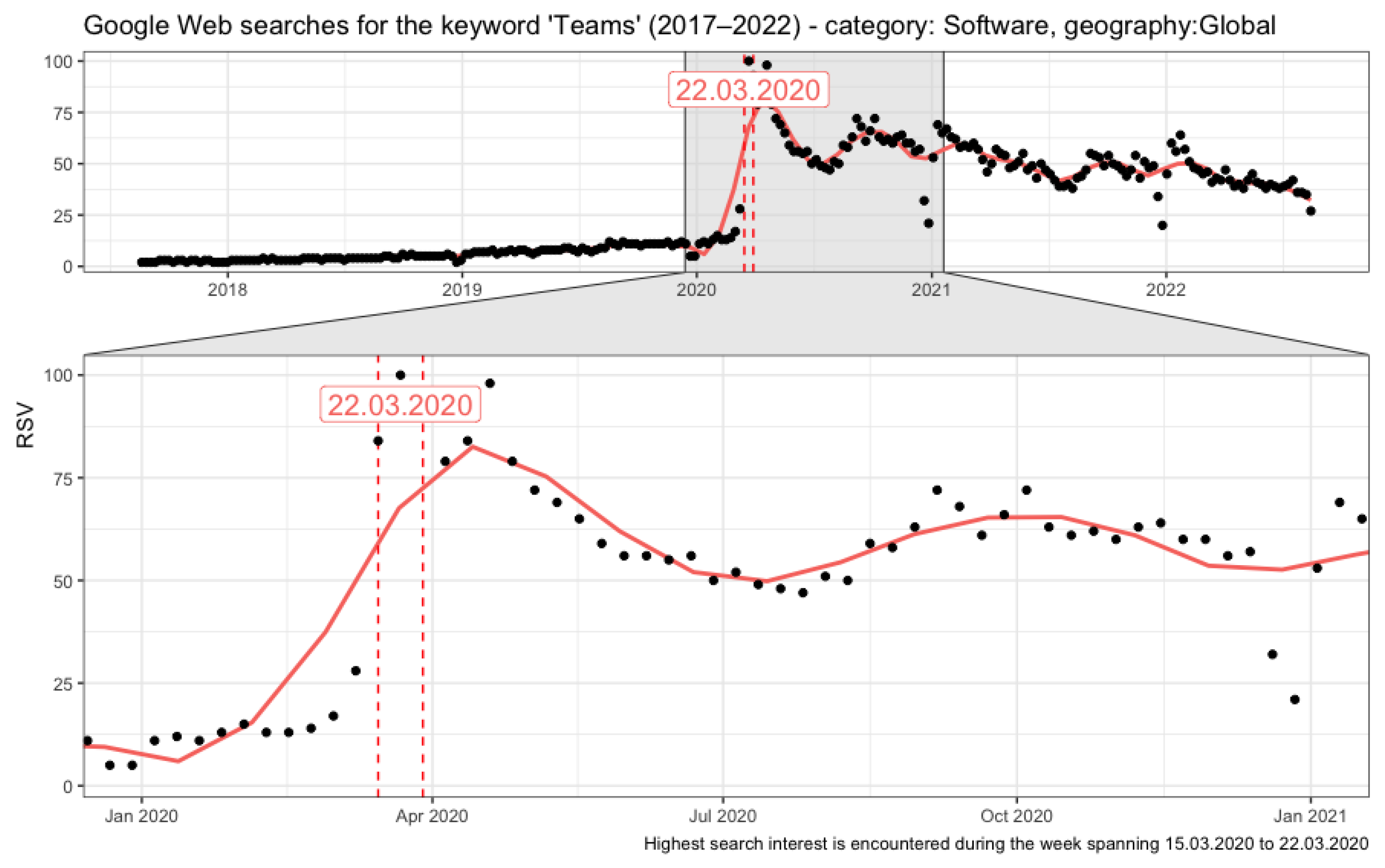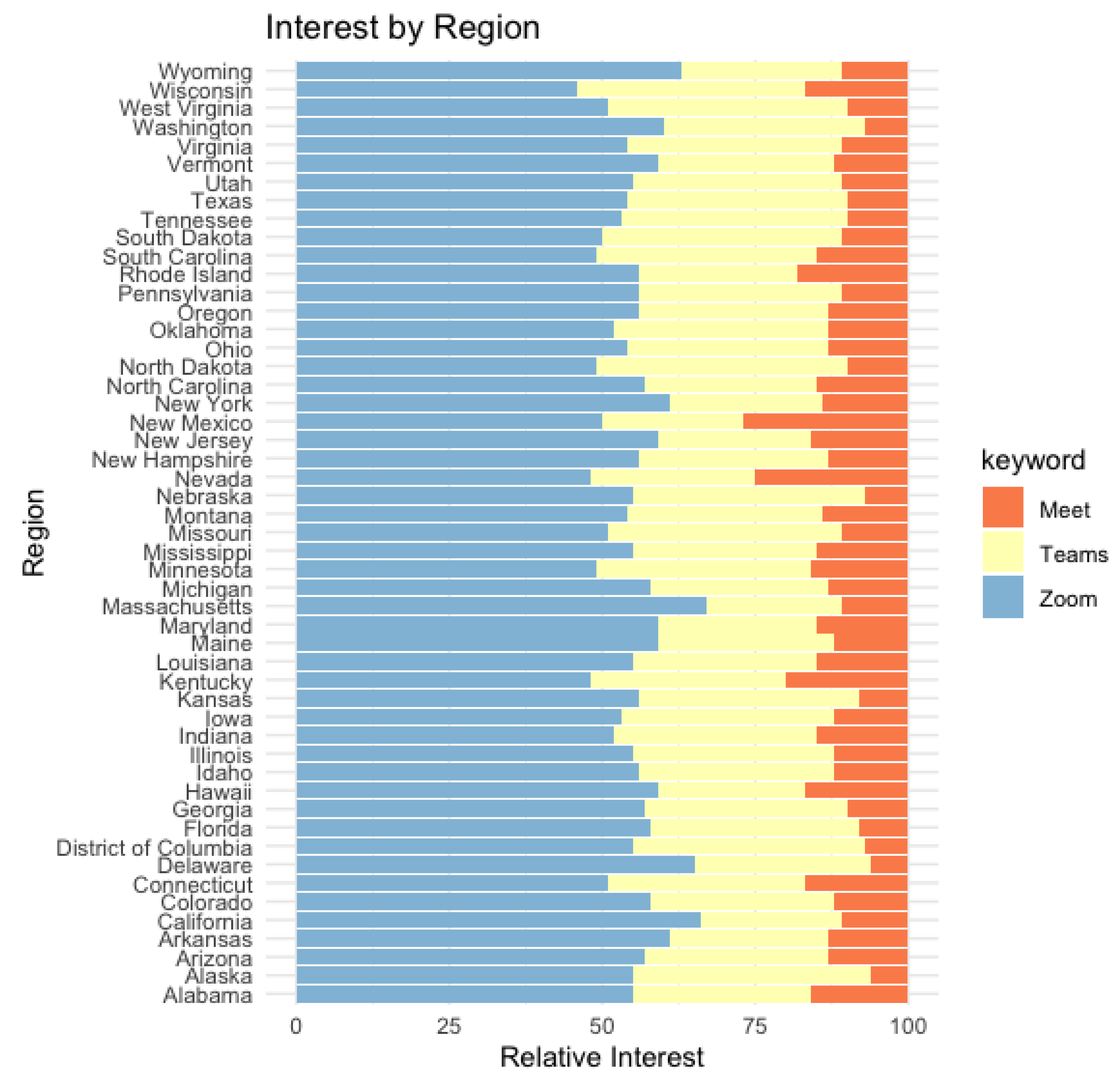The Impact of the COVID-19 Pandemic on the Global Web and Video Conferencing SaaS Market
Abstract
:1. Introduction
2. Materials and Methods
2.1. Data
2.1.1. Sample
2.1.2. Data Splitting
2.1.3. Trends in Search Interest for the Main Web and Videoconferencing SaaS Programs
2.2. Method
2.2.1. Forecasting Models
2.2.2. Evaluation Metrics
2.2.3. Automatic Forecasting Technique
- For each series (i.e., RSV Zoom and RSV Teams) fit all models (i.e., all specifications of ARIMA, ETS, and NNAR that are appropriate)
- Optimize model parameters
- Apply fitness function (i.e., AICc) to find the best model specifications in each category, for each series (i.e., best ARIMA, best ETS, best NNAR)
- Use the best model specifications in each category (i.e., best ARIMA, best ETS, best NNAR) and the naive model to issue point forecasts over the testing period (i.e., 31-steps ahead) for each series
- For each series, obtain accuracy measures over the testing window (out-of-sample) for predictions issued through the best model specifications in each category (ME, RMSE, MAE, MPE, MASE for best ARIMA, best ETS, best NNAR)
- Identify best out-of-sample forecasting model for each series (i.e., Mi)
- Re-estimate the corresponding Mi over the entire pre-pandemic window of length N = 131 for each series and optimize its parameters
- Use optimized specifications to issue forecasts over the first pandemic months for each series (forecasting horizon spanning February 2020–August 2020 or h = 27 weeks)
- Use predictions issued during step 8 as RSV baseline level for each series
- Compute excess search interest (i.e., actual RSV level–baseline) in the aftermath of the pandemic outbreak for the two time series corresponding to the relative search interest for the two main SaaS programs.
3. Results and Discussion
4. Discussion
5. Conclusions
Funding
Institutional Review Board Statement
Informed Consent Statement
Data Availability Statement
Conflicts of Interest
Appendix A


References
- Antwi, S.H.; Getty, D.; Linnane, S.; Rolston, A. COVID-19 water sector responses in Europe: A scoping review of preliminary governmental interventions. Sci. Total Environ. 2021, 762, 143068. [Google Scholar] [CrossRef] [PubMed]
- Gkatzelis, G.I.; Gilman, J.B.; Brown, S.S.; Eskes, H.; Gomes, A.R.; Lange, A.C.; McDonald, B.C.; Peischl, J.; Petzold, A.; Thompson, C.R.; et al. The global impacts of COVID-19 lockdowns on urban air pollutiona critical review and recommendations. Elem. Sci. Anthr. 2021, 9, 00176. [Google Scholar] [CrossRef]
- Mishra, N.P.; Das, S.S.; Yadav, S.; Khan, W.; Afzal, M.; Alarifi, A.; Kenawy, E.-R.; Ansari, M.T.; Hasnain, M.S.; Nayak, A.K. Global impacts of pre-and post-COVID-19 pandemic: Focus on socio-economic consequences. Sens. Int. 2020, 1, 100042. [Google Scholar] [CrossRef]
- Brauner, J.M.; Mindermann, S.; Sharma, M.; Johnston, D.; Salvatier, J.; Gavenčiak, T.; Stephenson, A.B.; Leech, G.; Altman, G.; Mikulik, V.; et al. Inferring the effectiveness of government interventions against COVID-19. Science 2021, 371, eabd9338. [Google Scholar] [CrossRef] [PubMed]
- Ashraf, B.N. Economic impact of government interventions during the COVID-19 pandemic: International evidence from financial markets. J. Behav. Exp. Financ. 2020, 27, 100371. [Google Scholar] [CrossRef]
- Desvars-Larrive, A.; Dervic, E.; Haug, N.; Niederkrotenthaler, T.; Chen, J.; Di Natale, A.; Lasser, J.; Gliga, D.S.; Roux, A.; Sorger, J.; et al. A structured open dataset of government interventions in response to COVID-19. Sci. Data 2020, 7, 285. [Google Scholar] [CrossRef]
- Sharma, M.; Mindermann, S.; Rogers-Smith, C.; Leech, G.; Snodin, B.; Ahuja, J.; Sandbrink, J.B.; Monrad, J.T.; Altman, G.; Dhaliwal, G.; et al. Understanding the effectiveness of government interventions against the resurgence of COVID-19 in Europe. Nat. Commun. 2021, 12, 5820. [Google Scholar] [CrossRef]
- Wang, Y.; Zhang, H.; Gao, W.; Yang, C. COVID-19-related government interventions and travel and leisure stock. J. Hosp. Tour. Manag. 2021, 49, 189–194. [Google Scholar] [CrossRef]
- Walmsley, T.; Rose, A.; Wei, D. The Impacts of the Coronavirus on the Economy of the United States. Econ. Disasters Clim. Change 2021, 5, 1–52. [Google Scholar] [CrossRef]
- United Nations Development Programme (UNDP). Brief# 2: Putting the UN Framework for Socio-Economic Response to COVID-19 into Action: Insights United Nations Development Programme. 2020. Available online: https://reliefweb.int/report/world/brief-2-putting-un-framework-socio-economic-response-covid-19-action-insights-june-2020 (accessed on 20 July 2022).
- Congressional Research Service (CRS). Global Economic Effects of COVID-19. 2021. Available online: https://sgp.fas.org/crs/row/R46270.pdf (accessed on 23 July 2022).
- United Nations (UN). COVID-19 to Slash Global Economic Output by $8.5 Trillion over Next Two Years. 2020. Available online: https://www.un.org/en/desa/covid-19-slash-global-economic-output-85-trillion-over-next-two-years (accessed on 20 July 2022).
- Aharon, D.Y.; Siev, S. COVID-19, government interventions and emerging capital markets performance. Res. Int. Bus. Financ. 2021, 58, 101492. [Google Scholar] [CrossRef]
- United Nations Development Programme (UNDP). Long-Term Socio-Economic Impacts of COVID-19 in African Contexts. 2021. Available online: https://www.undp.org/africa/long-term-socio-economic-impacts-covid-19-african-contexts (accessed on 20 July 2022).
- World Bank. BRIEF. Remote Learning During COVID-19: Lessons from Today, Principles for Tomorrow. 2021. Available online: https://www.worldbank.org/en/topic/edutech/brief/how-countries-are-using-edtech-to-support-remote-learning-during-the-covid-19-pandemic (accessed on 26 July 2022).
- Favale, T.; Soro, F.; Trevisan, M.; Drago, I.; Mellia, M. Campus traffic and e-Learning during COVID-19 pandemic. Comput. Netw. 2020, 176, 107290. [Google Scholar] [CrossRef]
- Ying, Y.H.; Siang, W.E.W.; Mohamad, M. The challenges of learning English skills and the integration of social media and video conferencing tools to help ESL learners coping with the challenges during COVID-19 pandemic: A literature review. Creat. Educ. 2021, 12, 1503–1516. [Google Scholar] [CrossRef]
- Maatuk, A.M.; Elberkawi, E.K.; Aljawarneh, S.; Rashaideh, H.; Alharbi, H. The COVID-19 pandemic and E-learning: Challenges and opportunities from the perspective of students and instructors. J. Comput. High. Educ. 2022, 34, 21–38. [Google Scholar] [CrossRef] [PubMed]
- World Economic Forum. The COVID-19 Pandemic Has Changed Education Forever. This Is How. 2020. Available online: https://www.weforum.org/agenda/2020/04/coronavirus-education-global-covid19-online-digital-learning/ (accessed on 27 July 2022).
- Research and Markets. Impact of COVID 19 on the Video Conferencing Market. 2020. Available online: https://www.researchandmarkets.com/reports/5013565/impact-of-covid-19-on-the-video-conferencing/ (accessed on 27 July 2022).
- Billingsley, L. Using video conferencing applications to share the death experience during the COVID-19 pandemic. J. Radiol. Nurs. 2020, 39, 275–277. [Google Scholar] [CrossRef]
- Bloomberg. Video Conferencing Market is Expected to Grow at a CAGR of 15.5% from 2021 to 2028 to Reach $24.4 Billion by 2028. 2022. Available online: https://www.bloomberg.com/press-releases/2022-03-08/video-conferencing-market-is-expected-to-grow-at-a-cagr-of-15-5-from-2021-to-2028-to-reach-24-4-billion-by-2028-according (accessed on 27 July 2022).
- CNN. Zoom’s Massive ‘Overnight Success’ Actually Took Nine Years. 2020. Available online: https://lite.cnn.com/en/article/h_3e6377be383adefdd63cb1c31723b17b (accessed on 20 July 2022).
- Fortune Business InsightsGlobal Video Conferencing Market Size, Share, and COVID-19 Impact Analysis 2022. Available online: https://www.fortunebusinessinsights.com/industry-reports/video-conferencing-market-100293 (accessed on 27 July 2022).
- Research and Markets. Web and Video Conferencing SaaS—Global Market Trajectory & Analytics. 2022. Available online: https://www.researchandmarkets.com/reports/5141267/web-and-video-conferencing-saas-global-market?utm_source=GNOM&utm_medium=PressRelease&utm_code=lf3smf&utm_campaign=1622545+-+Global+Web+and+Video+Conferencing+SaaS+Market+Report+2021%3a+Is+Zoom+Inching+towards+Market+Saturation%3f&utm_exec=chdo54prd (accessed on 24 July 2022).
- Tudor, C.; Sova, R. Infodemiological study on the impact of the COVID-19 pandemic on increased headache incidences at the world level. Sci. Rep. 2022, 12, 10253. [Google Scholar] [CrossRef]
- Silva, E.S.; Hassani, H.; Madsen, D.Ø.; Gee, L. Googling fashion: Forecasting fashion consumer behaviour using google trends. Soc. Sci. 2019, 8, 111. [Google Scholar] [CrossRef] [Green Version]
- Bleher, J.; Dimpfl, T. Today I got a million, tomorrow, I don’t know: On the predictability of cryptocurrencies by means of Google search volume. Int. Rev. Financ. Anal. 2019, 63, 147–159. [Google Scholar] [CrossRef]
- Jun, S.P.; Yoo, H.S.; Choi, S. Ten years of research change using Google Trends: From the perspective of big data utilizations and applications. Technol. Forecast. Soc. Change 2018, 130, 69–87. [Google Scholar] [CrossRef]
- Vosen, S.; Schmidt, T. Forecasting private consumption: Survey-based indicators vs. Google trends. J. Forecast. 2011, 30, 565–578. [Google Scholar] [CrossRef] [Green Version]
- Choi, H.; Varian, H. Predicting the present with Google Trends. Econ. Rec. 2012, 88, 2–9. [Google Scholar] [CrossRef]
- Hand, C.; Judge, G. Searching for the picture: Forecasting UK cinema admissions using Google Trends data. Appl. Econ. Lett. 2012, 19, 1051–1055. [Google Scholar] [CrossRef] [Green Version]
- Carrière-Swallow, Y.; Labbé, F. Nowcasting with Google Trends in an emerging market. J. Forecast. 2013, 32, 289–298. [Google Scholar] [CrossRef] [Green Version]
- Park, S.; Lee, J.; Song, W. Short-term forecasting of Japanese tourist inflow to South Korea using Google trends data. J. Travel Tour. Mark. 2017, 34, 357–368. [Google Scholar] [CrossRef]
- Clark, M.; Wilkins, E.J.; Dagan, D.T.; Powell, R.; Sharp, R.L.; Hillis, V. Bringing forecasting into the future: Using Google to predict visitation in US national parks. J. Environ. Manag. 2019, 243, 88–94. [Google Scholar] [CrossRef] [PubMed]
- Yu, L.; Zhao, Y.; Tang, L.; Yang, Z. Online big data-driven oil consumption forecasting with Google trends. Int. J. Forecast. 2019, 35, 213–223. [Google Scholar] [CrossRef]
- Long, C.L.; Guleria, Y.; Alam, S. Air passenger forecasting using Neural Granger causal Google trend queries. J. Air Transp. Manag. 2021, 95, 102083. [Google Scholar] [CrossRef]
- Stavinova, E.; Chunaev, P.; Bochenina, K. Forecasting railway ticket dynamic price with Google Trends open data. Procedia Comput. Sci. 2021, 193, 333–342. [Google Scholar] [CrossRef]
- Yakubu, H.; Kwong, C.K. Forecasting the importance of product attributes using online customer reviews and Google Trends. Technol. Forecast. Soc. Change 2021, 171, 120983. [Google Scholar] [CrossRef]
- Siliverstovs, B.; Wochner, D.S. Google Trends and reality: Do the proportions match?: Appraising the informational value of online search behavior: Evidence from Swiss tourism regions. J. Econ. Behav. Organ. 2018, 145, 1–23. [Google Scholar] [CrossRef]
- Hassani, H.; Silva, E.S. Forecasting with big data: A review. Ann. Data Sci. 2015, 2, 5–19. [Google Scholar] [CrossRef] [Green Version]
- Munim, Z.H.; Shakil, M.H.; Alon, I. Next-day bitcoin price forecast. J. Risk Financ. Manag. 2019, 12, 103. [Google Scholar] [CrossRef] [Green Version]
- Tudor, C. A Novel Approach to Modeling and Forecasting Cancer Incidence and Mortality Rates through Web Queries and Automated Forecasting Algorithms: Evidence from Romania. Biology 2022, 11, 857. [Google Scholar] [CrossRef] [PubMed]
- Breiman, L. Statistical modeling: The two cultures (with comments and a rejoinder by the author). Stat. Sci. 2001, 16, 199–231. [Google Scholar] [CrossRef]
- Hyndman, R.J.; Athanasopoulos, G. Evaluating Forecast Accuracy. In Forecasting: Principles and Practice, 2nd ed.; OTexts: Melbourne, Australia, 2018; Section 3.4; Available online: https://otexts.com/fpp2/accuracy.html (accessed on 20 June 2022).
- Breitung, J.; Knüppel, M. How far can we forecast? Statistical tests of the predictive content. J. Appl. Econom. 2021, 36, 369–392. [Google Scholar] [CrossRef]
- Massicotte, P.; Eddelbuettel, D. Package gtrendsR, Perform and Display Google Trends Queries. 2022. Available online: https://cran.r-project.org/web/packages/gtrendsR/gtrendsR.pdf (accessed on 20 June 2022).
- Cleveland, W.S. Robust Locally Weighted Regression and Smoothing Scatterplots. J. Am. Stat. Assoc. 1979, 74, 829–836. [Google Scholar] [CrossRef]
- Cleveland, W.S.; Devlin, S.J. Locally Weighted Regression: An Approach to Regression Analysis by Local Fitting. J. Am. Stat. Assoc. 1988, 83, 596–610. [Google Scholar] [CrossRef]
- Holt, C.C. Forecasting Seasonals and Trends by Exponentially Weighted Averages (O.N.R. Memorandum No. 52); Carnegie Institute of Technology: Pittsburgh, PA, USA, 1957. [Google Scholar]
- Winters, P.R. Forecasting sales by exponentially weighted moving averages. Manag. Sci. 1960, 6, 324. [Google Scholar] [CrossRef]
- Brown, R.G. Statistical Forecasting for Inventory Control; McGraw Hill: New York, NY, USA, 1959. [Google Scholar]
- Yang, D.; Sharma, V.; Ye, Z.; Lim, L.I.; Zhao, L.; Aryaputera, A.W. Forecasting of global horizontal irradiance by exponential smoothing, using decompositions. Energy 2015, 81, 111–119. [Google Scholar] [CrossRef] [Green Version]
- Perone, G. Comparison of ARIMA, ETS, NNAR, TBATS and hybrid models to forecast the second wave of COVID-19 hospitalizations in Italy. Eur. J. Health Econ. 2021, 123, 917–940. [Google Scholar] [CrossRef]
- Hyndman, R.J.; Khandakar, Y. Automatic time series forecasting: The forecast package for R. J. Stat. Softw. 2008, 26, 1–22. [Google Scholar] [CrossRef] [Green Version]
- Hyndman, R.; Athanasopoulos, G.; Bergmeir, C.; Caceres, G.; Chhay, L.; O’Hara-Wild, M.; Petropoulos, F.; Razbash, S.; Wang, E.; Yasmeen, F. Forecast: Forecasting Functions for Time Series and Linear Models. R Package Version 8.16. 2022. Available online: https://pkg.robjhyndman.com/forecast/ (accessed on 20 June 2022).
- Box, G.; Jenkins, G. Time Series Analysis: Forecasting and Control; Holden-Day: San Francisco, CA, USA, 1970. [Google Scholar]
- Pasini, A. Artificial neural networks for small dataset analysis. J. Thorac. Dis. 2015, 7, 953. [Google Scholar] [PubMed]
- Allende, H.; Moraga, C.; Salas, R. Artificial neural networks in time series forecasting: A comparative analysis. Kybernetika 2002, 38, 685–707. [Google Scholar]
- Tudor, C.; Sova, R. Benchmarking GHG Emissions Forecasting Models for Global Climate Policy. Electronics 2021, 10, 3149. [Google Scholar] [CrossRef]
- Hyndman, R.J.; Koehler, A.B. Another look at measures of forecast accuracy. Int. J. Forecast. 2006, 22, 679–688. [Google Scholar] [CrossRef] [Green Version]
- Narita, M.F.; Yin, R. In Search of Information: Use of Google Trends’ Data to Narrow Information Gaps for Low-Income Developing Countries; International Monetary Fund: 2018. Available online: https://www.elibrary.imf.org/view/journals/001/2018/286/article-A001-en.xml (accessed on 25 July 2022).
- Medeiros, M.C.; Pires, H.F. The Proper Use of Google Trends in Forecasting Models. arXiv 2021, arXiv:2104.03065. [Google Scholar]
- Stephens-Davidowitz, S.; Varian, H. A Hands-On Guide to Google Data. 2014. Available online: https://people.ischool.berkeley.edu/~hal/Papers/2015/primer.pdf (accessed on 25 July 2022).
- S&P Global. Zoom Jumps into Contact Center Market as Pressure to Diversify Grows. 2022. Available online: https://www.spglobal.com/marketintelligence/en/news-insights/latest-news-headlines/zoom-jumps-into-contact-center-market-as-pressure-to-diversify-grows-69076264 (accessed on 29 July 2022).
- Trust Radius. 84 Current Video Conferencing Statistics for the 2021 Market. 2021. Available online: https://www.trustradius.com/vendor-blog/web-conferencing-statistics-trends (accessed on 25 July 2022).
- Boone, T.; Ganeshan, R.; Hicks, R.L.; Sanders, N.R. Can Google trends improve your sales forecast? Prod. Oper. Manag. 2018, 27, 1770–1774. [Google Scholar] [CrossRef]






| Out-of-sample forecasts for RSV Zoom | |||||
| ME | RMSE | MAE | MPE | MASE | |
| NN | 0.51 | 0.81 | 0.71 | 9.14 | 3.92 |
| ETS | 0.48 | 0.79 | 0.70 | 8.46 | 3.88 |
| ARIMA | 0.49 | 0.79 | 0.71 | 8.50 | 3.87 |
| NAIVE | 0.59 | 0.86 | 0.74 | 10.86 | 4.07 |
| Out-of-sample forecasts for RSV Teams | |||||
| ME | RMSE | MAE | MPE | MASE | |
| NN | 1.65 | 2.43 | 2.23 | 13.84 | 5.03 |
| ETS | −0.69 | 2.16 | 1.34 | −13.34 | 3.02 |
| ARIMA | 0.69 | 1.89 | 1.61 | 2.84 | 3.62 |
| NAIVE | 1.07 | 2.06 | 1.89 | 7.23 | 4.25 |
Publisher’s Note: MDPI stays neutral with regard to jurisdictional claims in published maps and institutional affiliations. |
© 2022 by the author. Licensee MDPI, Basel, Switzerland. This article is an open access article distributed under the terms and conditions of the Creative Commons Attribution (CC BY) license (https://creativecommons.org/licenses/by/4.0/).
Share and Cite
Tudor, C. The Impact of the COVID-19 Pandemic on the Global Web and Video Conferencing SaaS Market. Electronics 2022, 11, 2633. https://doi.org/10.3390/electronics11162633
Tudor C. The Impact of the COVID-19 Pandemic on the Global Web and Video Conferencing SaaS Market. Electronics. 2022; 11(16):2633. https://doi.org/10.3390/electronics11162633
Chicago/Turabian StyleTudor, Cristiana. 2022. "The Impact of the COVID-19 Pandemic on the Global Web and Video Conferencing SaaS Market" Electronics 11, no. 16: 2633. https://doi.org/10.3390/electronics11162633
APA StyleTudor, C. (2022). The Impact of the COVID-19 Pandemic on the Global Web and Video Conferencing SaaS Market. Electronics, 11(16), 2633. https://doi.org/10.3390/electronics11162633






